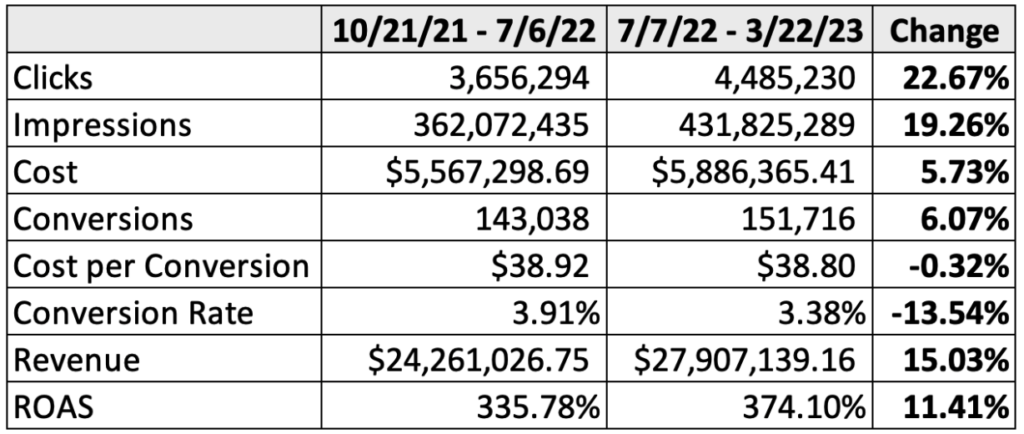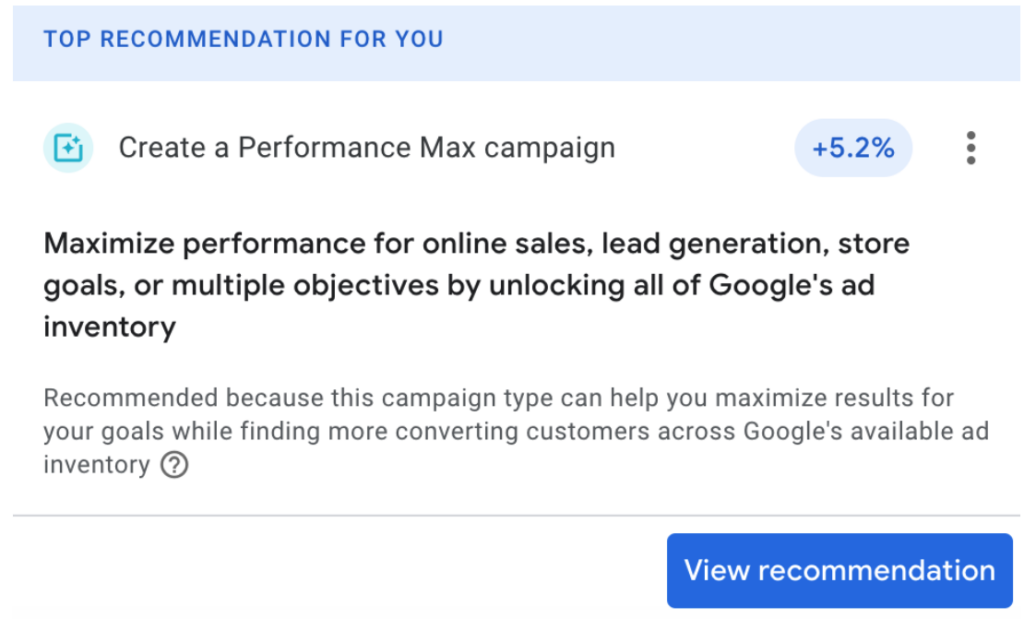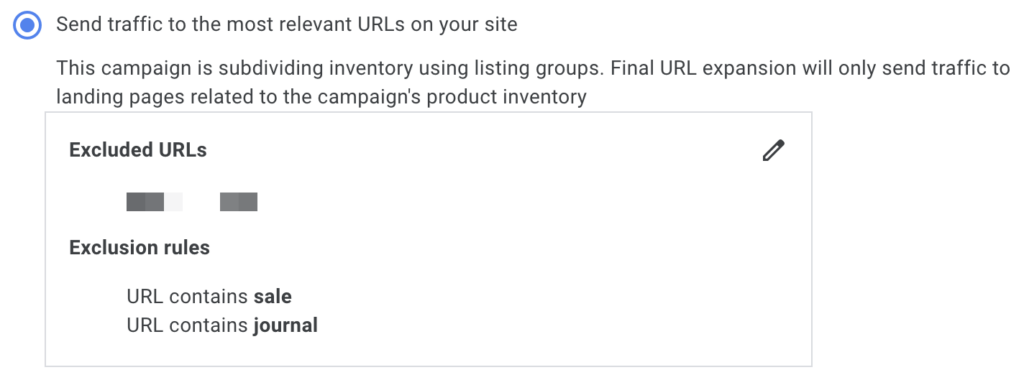Performance Max campaigns represent a fundamental shift in how advertisers manage Google Ads accounts. Advertisers have historically been able to control campaign targeting while reporting on the granular data needed. As automated and responsive features such as smart bidding, responsive search ads and machine learning have progressed, there have been fewer levers for advertisers to push and less reporting transparency. Performance Max campaigns highlight this lack of control while also presenting advertisers the ability to show their value.
Google will continue to invest in and refine Performance Max campaigns.
Over time, advertisers can reasonably expect more levers and insight to be available, but Performance Max campaigns will always largely be automated. Rather than avoid Performance Max campaigns, they should be embraced and given the right inputs to succeed. These inputs include:
In addition to Google’s automation technologies, the “all-encompassing” nature of Performance Max campaigns make them favorable. In a single campaign, ads can show across all of Google’s inventory, including:
By submitting all your assets, Google will responsively show them across the various ad formats. Performance Max saves advertisers time by not creating many campaigns targeting different networks. This campaign type is more efficient from a budget standpoint because it spends where performance is expected to be best.
Performance Max opposes the philosophy that campaigns should be network specific. For example, if you are running a Search campaign, then you should only target the Search network. Performance Max is different because no keywords are involved. Since audience signals drive activity and ads are responsive, the network isn’t as important. In other words, ads will show across the various networks based on user intent.
Google states that Search campaigns are prioritized over Performance Max campaigns If the user’s query is identical to an eligible Search keyword of any match type in your account. For example, if you are bidding on the term “blue widgets” in phrase match, users should see the ad from your Search campaign for a search of “blue widgets in bulk.” This scenario is not always the case. Later on, we’ll review how to better ensure that the right ad shows.
The incremental gains with Performance Max make it worthwhile to run. Though there are concerns about Performance Max campaigns taking traffic from other campaigns, advertisers see an overall account uplift when running PMax. For an e-comm client, after Performance Max campaigns began running, there was a distinctive increase in account metrics. Here is a before and after view.

With Performance Max running, account clicks and impressions increased by at least 19%. Conversions and cost increased by 6% while cost per conversion decreased slightly. Revenue and ROAS both improved with Performance Max running.
It’s essential to remember that several variables impact account performance beyond Performance Max. Budgets may change, new campaign types are added, keywords are paused, and more. Though Performance Max may be the primary reason for the overall account uplift, it isn’t the only one.
In another example, all traffic metrics increased by at least 79% after Performance Max campaigns began running.

Cost per conversion increased by $5, and the conversion rate declined by 13%, but there were 14K more conversions. In this account, clicks from separate Display, Video, and Discovery campaigns also saw double and triple-digit percentage increases.
Suggested Reading: Performance Max: Managing the Automated
Finally, Performance Max is the future of Google Ads. Smart Shopping and Local campaigns have already been sunsetted. The features from these campaign types are now in Performance Max. It wouldn’t be surprising if other campaign types, such as Shopping and Dynamic Search Ads follow suit. Google also shows Performance Max as a top recommendation to improve optimization score and account performance.

Even though optimization score is a secondary metric, the fact that it is highlighted shows us Google’s intentions. Advertisers need to commit to Performance Max.
Beyond the standard settings inherent in every campaign (i.e., budget, location, bid strategy, etc.), Performance Max contains three settings that must be carefully reviewed.
The most important setting is to choose the right goals. You should not use account goal settings because Google will optimize toward the easiest conversions to achieve, which are usually at the top of the funnel. You may see many conversions, but they will most likely be softer conversions such as asset form submissions and micro events. Use campaign-specific goal settings to optimize toward bottom-of-the-funnel conversions.

Even when optimizing toward the bottom-of-the-funnel conversions, spam leads will still come in. One of the negative aspects of the additional inventory is that many sites are of poor quality. For lead gen accounts, it’s recommended to only run Performance Max campaigns when offline conversion tracking (OCT) is set up. Telling Google to only optimize toward your highest quality conversion points will drastically improve the success of Performance Max.
Customer acquisition is the second setting that needs to be assessed. The option exists to optimize the campaign for acquiring new customers, whether by bidding higher for new customers or only bidding for new ones. Advertisers who want to target new users and already have retention campaigns primarily should choose this option. Bidding higher for new customers should be the subset choice, so the campaign will still target all users, even if some are returning. Advertisers can define an additional conversion value for new customers.

If the client is stringent about targeting new customers, then the “only bid for new customers” option should be checked. Existing customers may still come through if Google can’t identify the user.
The final setting is final URL expansion. Like DSA campaigns, Google may replace the provided final URL with one it deems more relevant. Consider turning this setting off when launching new Performance Max lead gen campaigns. Instead, create segmented asset groups with their own assets and landing pages. As the campaigns mature and performance is in a good position, final URL expansion is worth testing. For e-comm campaigns, turning on final URL expansion from launch is recommended so users can potentially go directly to product description pages.
If final URL expansion is on, ensure that excluded URLs are set up. As with DSA negative dynamic targets, exclude URLs you don’t want traffic to land.

There are two account-level settings that need to be considered when running Performance Max campaigns. The first is account-level negative keywords. These account-level negatives apply to Search, Shopping, and Performance Max campaigns. Campaign-level negative keywords cannot be set up for Performance Max in the interface, but Google reps can implement them on their side.
The second setting is content suitability, which determines the types of content that ads are seen. The standard inventory option is acceptable to begin with. Switch to limited inventory if ads are being shown too much on sites with sensitive content. Confer with the client to make this decision.

Asset groups are the core of Performance Max campaigns and most similar to traditional ad groups. Within an asset group is where you will add all of your text, creative, and audience signals. Listing groups from a product feed (for ecomm accounts) are also created in an asset group. As with Responsive Search Ads (RSAs), Performance Max works best when you submit as many assets as possible.
Advertisers should submit:
Note that Google will automatically create videos if none are provided.
Assets should be relevant to the asset group. For example, if the theme of the asset group is to “automate workflows,” then the images and text should reinforce this solution.
The more assets that are included, the better the ad strength will be.
Remember that the main benefit of a higher ad strength is that ads will see more impressions. A higher ad strength doesn’t always result in more conversions or a higher conversion rate. Keep this in mind when auditing performance. To this end, Google will assign a performance score to every asset of low, good or best. Since conversion metrics aren’t available by asset, this score is a vanity metric that should be reviewed when updating assets.
Every asset group needs to be assigned an audience signal. This signal differentiates the targeting by asset group. For example, an audience signal targeting past visitors may include additional product benefits. An audience signal targeting an in-market audience may have more general messaging about the product. The caveat is that audience signals act only as a starting point. Google will expand your audiences if it deems it can capture new conversions.
Audience signals can contain any variation of:
There is no one correct way to set up Performance Max campaigns. Advertisers can create a campaign targeting a theme and use asset groups around various audience types and where they are in the funnel. The setup could also capture new users in one campaign and returning visitors in another, regardless of the theme. Every setup will be flawed since Google takes liberties with audience signals.
Retargeting audiences will be highly targeted audience signals to start. Other relevant audiences include:
Advertisers should consider implementing brand lists to negate their own brand traffic and/or other brands. Brand lists negate the brand completely, whereas negative keywords may still allow for misspellings and variants. In e-comm accounts, this feature is relevant if there are low-margin brands that advertisers don’t want to promote. Brand lists are not available in every account and will be rolled out throughout 2023.
Clients are justifiably concerned about Performance Max campaigns having a negative impact. They don’t have as many levers as existing campaign types and reporting is not transparent. Running an uplift experiment is one way to test Performance Max without going all in.
Advertisers can run a 50/50 Performance Max campaign against existing campaigns to measure overall uplift. Google deems which existing campaigns are comparable to the Performance Max campaign. Though advertisers can’t choose the campaigns Performance Max runs against, they are able to see individual campaign data.

This uplift experiment aims to garner more conversions at a similar CPL. Clients may test more Performance Max campaigns and/or move away from other campaign types if this goal is reached.
The starting budget for Performance Max should be 20% – 30% of the overall budget. If the client spends $100K a month, $20K – $30K should be allocated for Performance Max. Similar to experiments, Performance Max campaigns should be launched against other campaign types. Some existing campaigns will likely see less traffic once Performance Max is launched. As long as these existing campaigns perform well and meet a specific need (i.e., a brand Search campaign when brand negatives are added to Performance Max campaigns), they should continue running.
If additional budget isn’t an option, Performance Max isn’t the right fit (at this time). It needs the extra budget to give it a legitimate chance to succeed and show overall account growth. Network-specific campaigns are preferred if clients want to branch into initiatives like Video and Display on a limited budget. Individual network campaigns have more targeting options and more transparent reporting.
Performance Max campaigns are in their infancy. Though the industry has developed tactics and thoughts to make this campaign type successful, there is more to accomplish. Advertisers should test different ideas, grounded in educated hypotheses. Performance Max is here to stay.
All the latest digital advertising tips and industry insights delivered to your inbox every quarter

The B2B landscape is relentless, and mediocre video production won’t cut it. Learn why scaling high-quality video production is essential to drive ROI, stand out, and stay competitive in today’s paid media game.

Misaligned metrics and fragmented strategies aren’t just inconvenient—they’re costing your marketing team revenue and results. Explore the root causes of data chaos and learn how to align your metrics for paid media success.

AI tools promise automation and efficiency, but without human expertise in creative, strategy, and oversight, they amplify inefficiencies. Learn how to balance AI’s strengths with human intervention to drive results.